Assemblage-information for GCSE Art Students
Jane Fairhurst gained her Masters Degree in Fine Art with distinction from Liverpool Art and Design Academy in 2010.
Her practice encompasses a wide range of media including drawing, painting, mixed media and traditional ‘craft’ skills.
Often using ethnographic artifacts as her starting point she makes work that explores the transformative power of art to question all manner of issues in contemporary society.
Combining her fine art craft skills and a wicked sense of humour she focuses upon her chosen subject be it the environment, feminism, global politics or societal issues.
‘Assemblage is a work of art made by grouping together found or unrelated objects.’
“I collect the objects I use in my work from many places. Charity shops, car boot sales, pound shops and museum shops provide me with objects such as toys, small objects, fossils, boxes, cages, glass domes etc. I collect organic materials when I’m out walking in the countryside or on a beach and I use things I find in my home and garden such as animal bones, seed pods, skulls of dead birds and small animals, plant and tree roots, tree branches etc.” Jane Fairhurst
Artists using assemblage
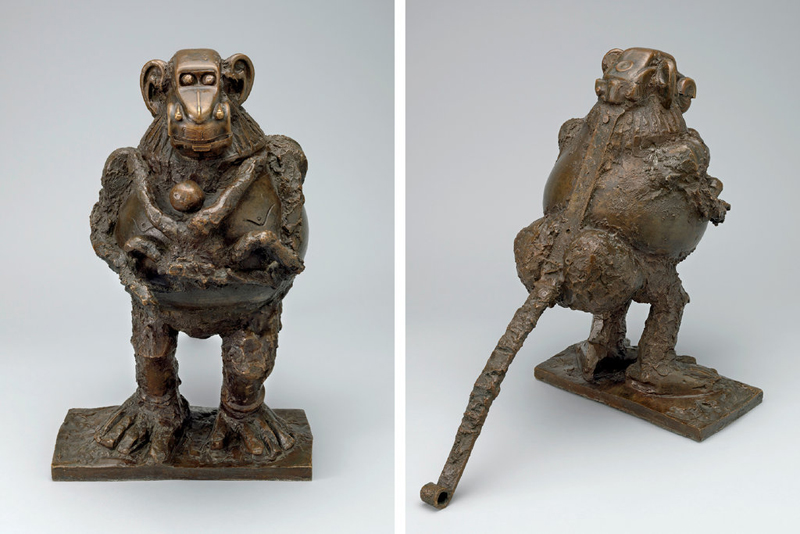
Picasso’s Baboon and Young 1951 Bronze cast of assembled materials
Pablo Picasso is regarded as one of the first artists to group unrelated objects in his work. He included toys, bicycle handlebars and other materials in his sculptural works. I found inspiration in Picasso’s assemblages and those of artists Kurt Schwitters and Joseph Cornell but the work that has inspired me since childhood is that found in museums under the heading ‘Ethnographic Artifacts’. Artifacts such as Nkondi, fetish objects of the Kongo peoples of central Africa and Yup’ik masks of the Inuit peoples of the Arctic.
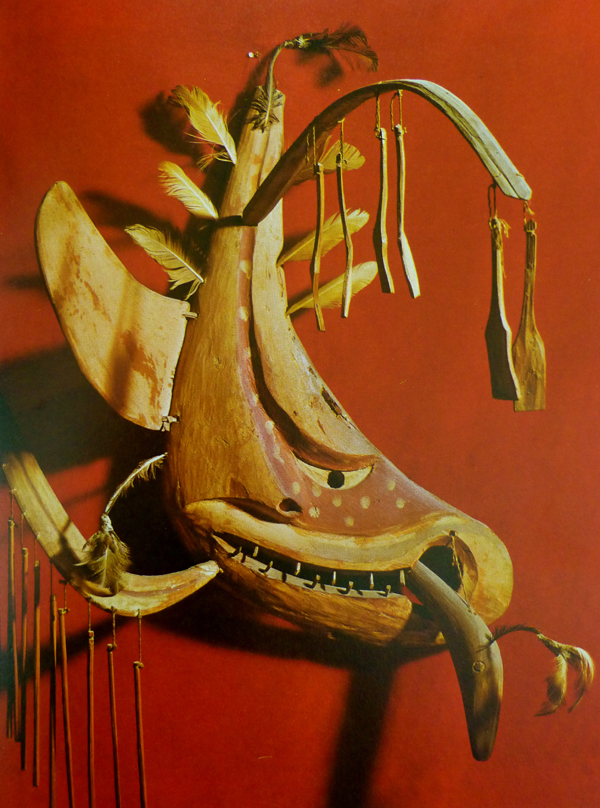
Yup’ik mask -late 19th century-this mask was part of the Surrealist Andre Breton’s collection
Artists whose work has inspired me include:
Louise Bourgeois, Cornelia Parker, Annette Messager, Susan Hiller, Cathy de Monchaux, Dorothy Cross, Mark Dion, Mike Kelley, Richard Wentworth, Rose Garrard, Jake and Dinos Chapman, Eva Hesse, Grayson Perry.
Here are a selection of my mixed media assemblages from 2001-2016.
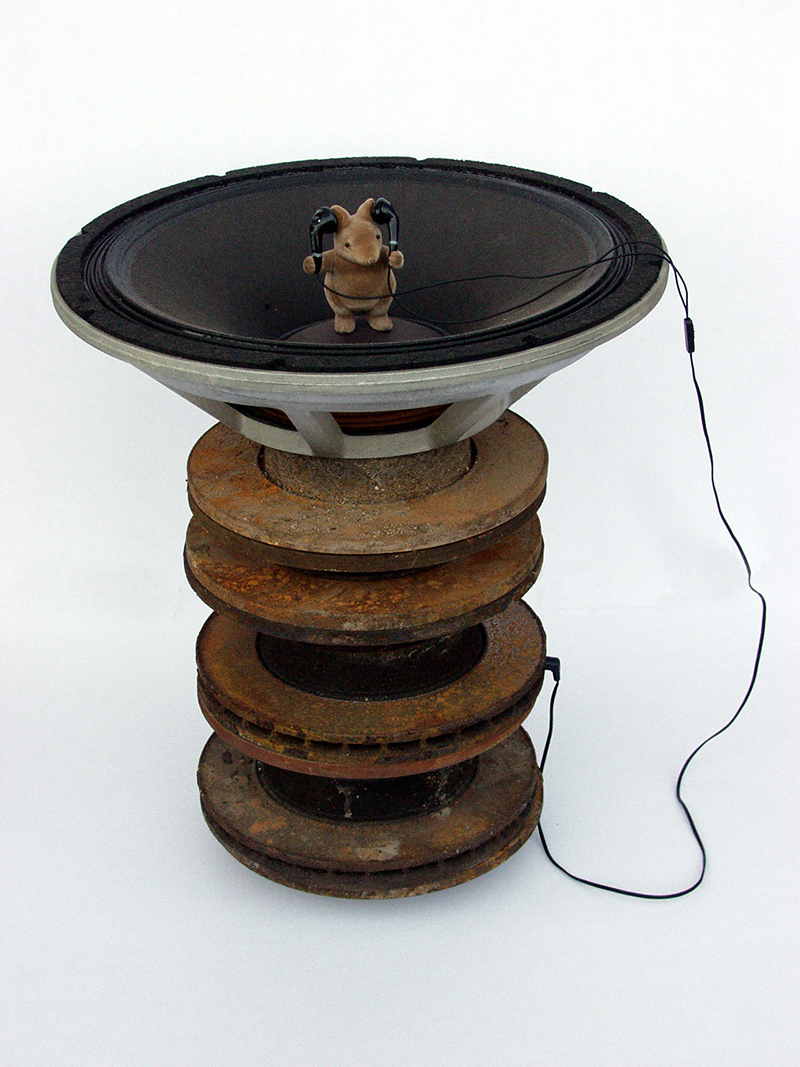
Can U Hear Me? – 2001 mixed media assemblage – toy mouse, headphones, speaker cone, rusted car brake shoes.
Here I’m addressing the noisy world we inhabit from traffic noise and airplanes flying overhead to ‘musak’ in shops and shopping centres.
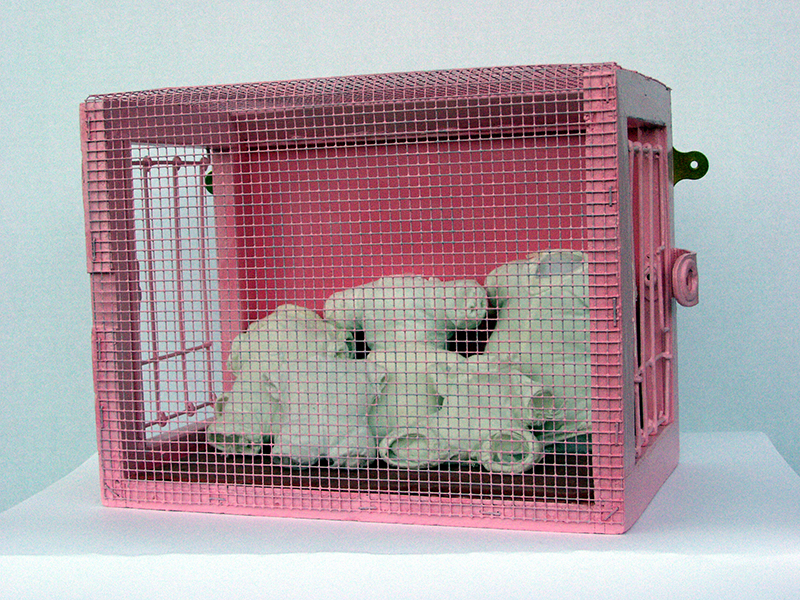
Pink Cage 2002
Converted pigeon carrier, doll bodies with heads, arms and legs removed, pink velvet, pink paint.
This piece represents an emotionally difficult time in my life. The bodies are trapped inside the pretty pink, unlocked cage, unable to move as they lack arms, legs and heads….sometimes life feels like this.
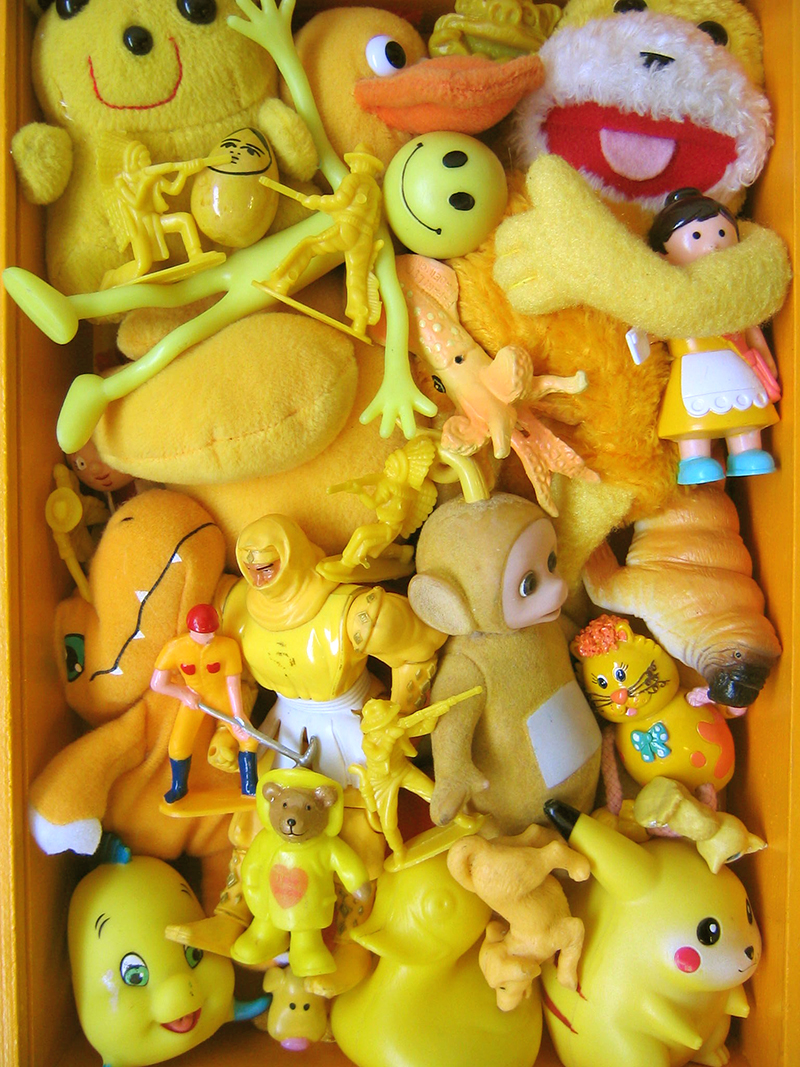
Colour Box Series-Yellow 2004 – toys assembled into boxes by colour
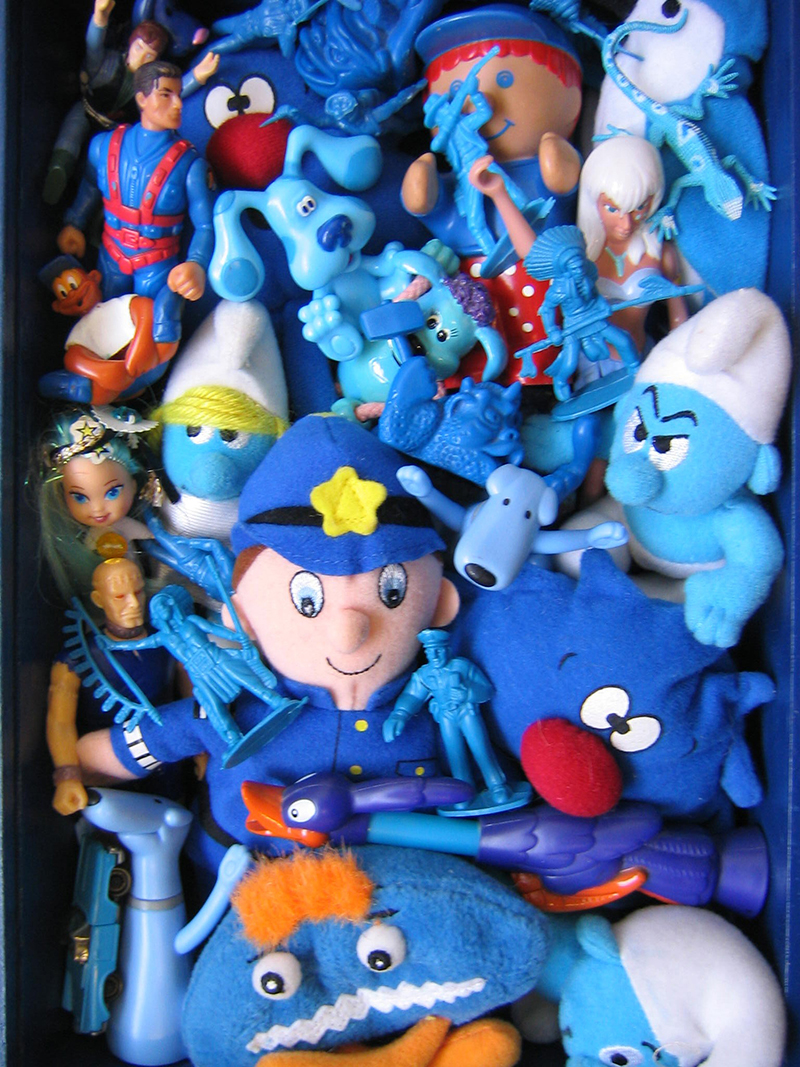
Colour Box Series-Blue
There are 17 boxes in this series, all different colours and resembling an artist’s paintbox. They are also a memory box for 2004 and a critique of consumerism, using the earth’s valuable resources to make toys that are soon discarded.
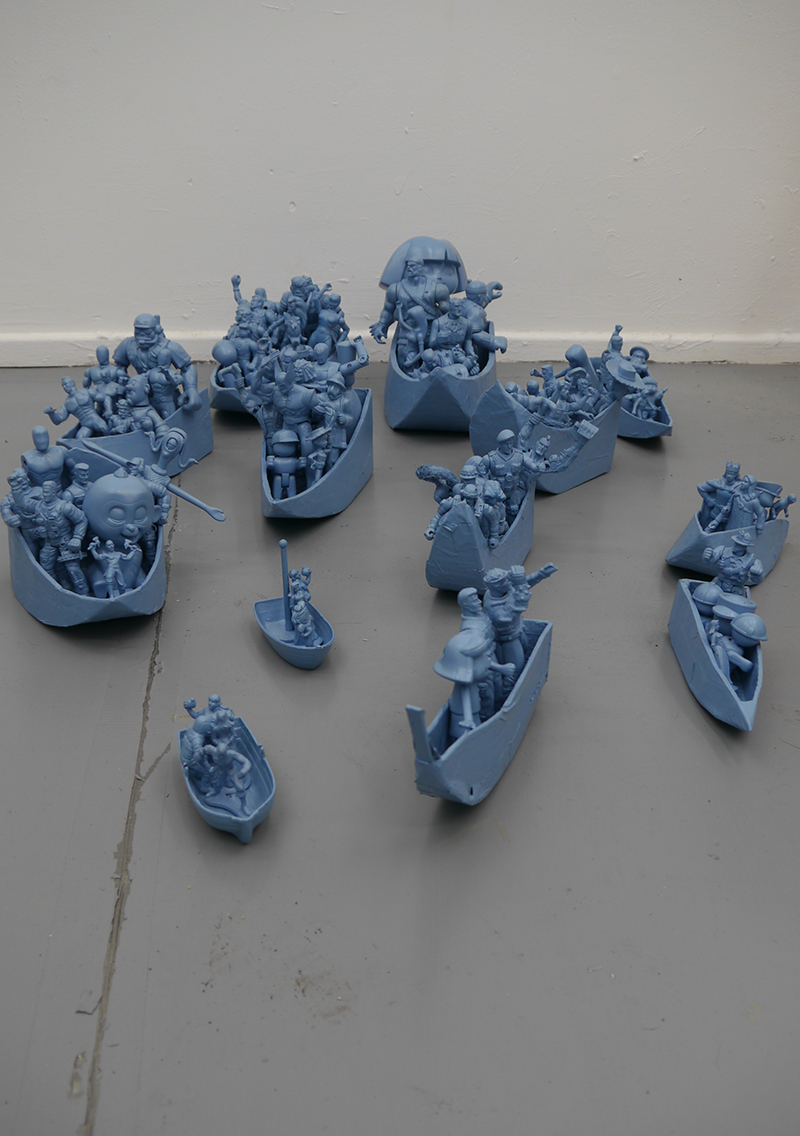
Over the Water-2008 mixed media assemblage
Originally made for the 2008 Liverpool Biennial Over the water was my response to the theme of Migration. The work is comprised of a series of boats constructed from cardboard and tape and filled with toy figures that are painted blue/grey as a means to remove individuality from both figures and boats.
With the current refugee crisis resulting from instability and war in the Middle East the work is as relevant today as it was back in 2008.
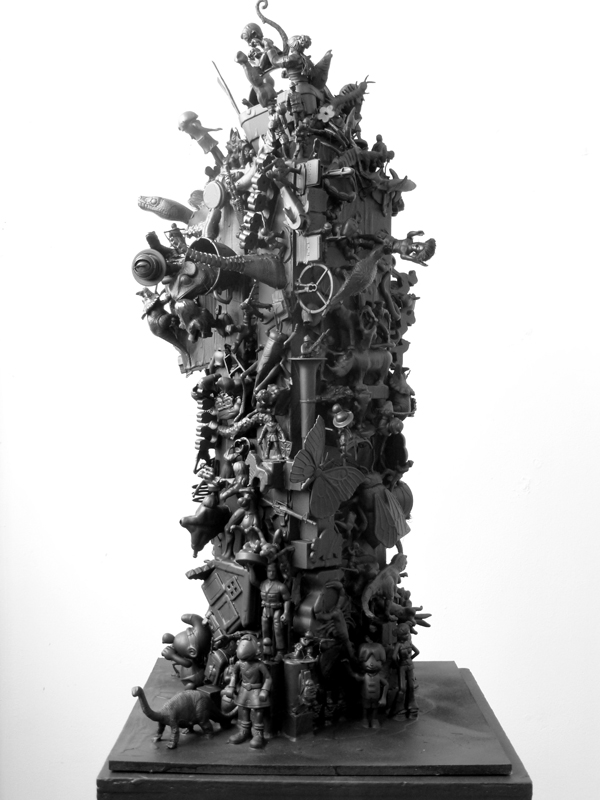
High Rise 2008 mixed media assemblage
This piece was inspired by the biblical story of the Tower of Babel and J.G. Ballard’s dystopian novel High Rise.
[
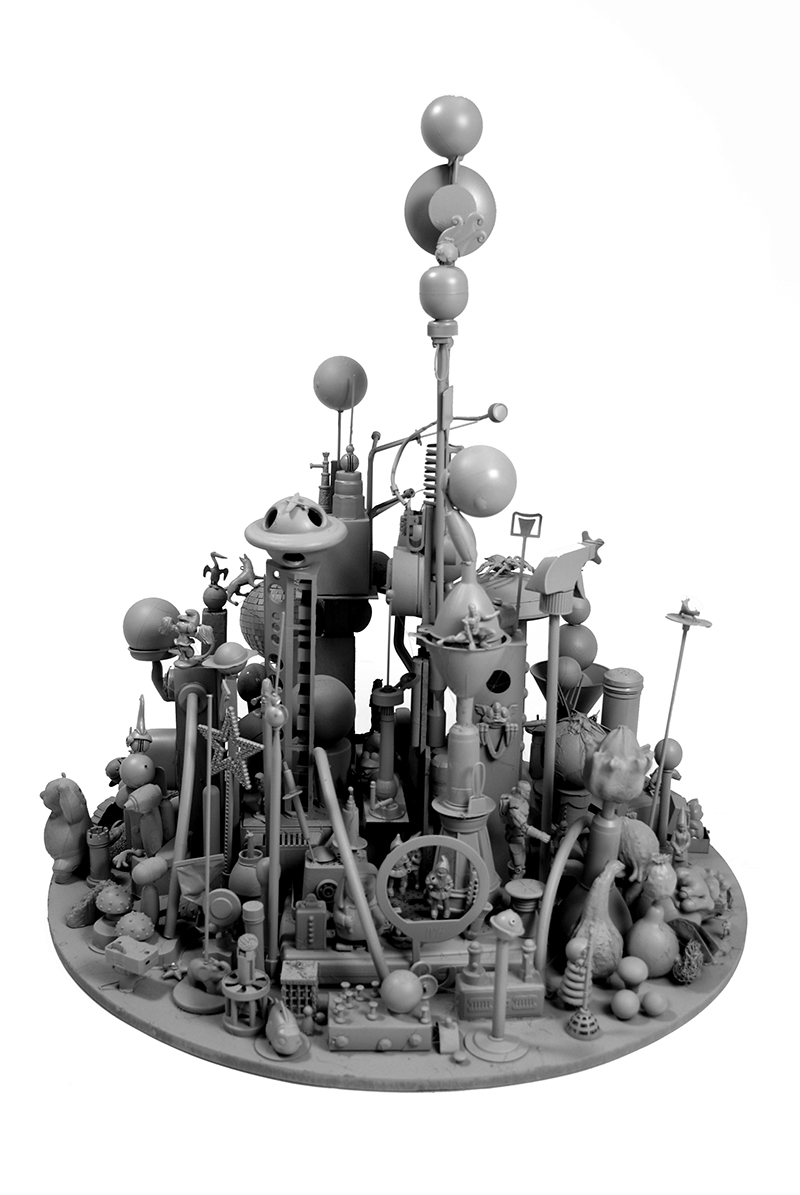
Zing Hong 2009 – mixed media assemblage
This sculptural work was made in collaboration with fellow student Tim Fielding. We worked together from 2008-2010 during the time we were studying for our Masters Degree. We made a series of these ‘disk’ works which came together with other assemblages to create one huge city.
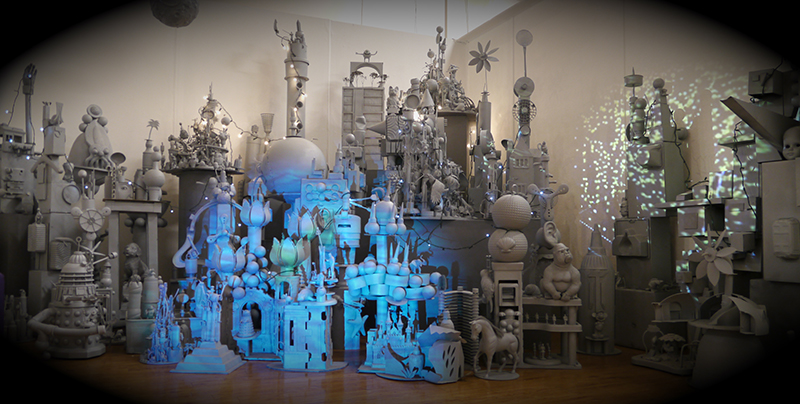
History of the Future-2009 large scale installation/assemblage
The photograph of this large scale work was taken when it was exhibited at Chapel Gallery, Ormskirk in 2012. The installation included a series of images projected onto the work and a recording of ‘city’ sounds, traffic, planes, people, dogs barking etc.
History of the Future is a complex work that critiques political ideologies, social systems and the impact of art and design and architecture, prompting questions relating to the fabric of our built environment, how and why it has developed in the way it has, who makes these decisions and, ultimately, what effect the place we live in has on our lives.
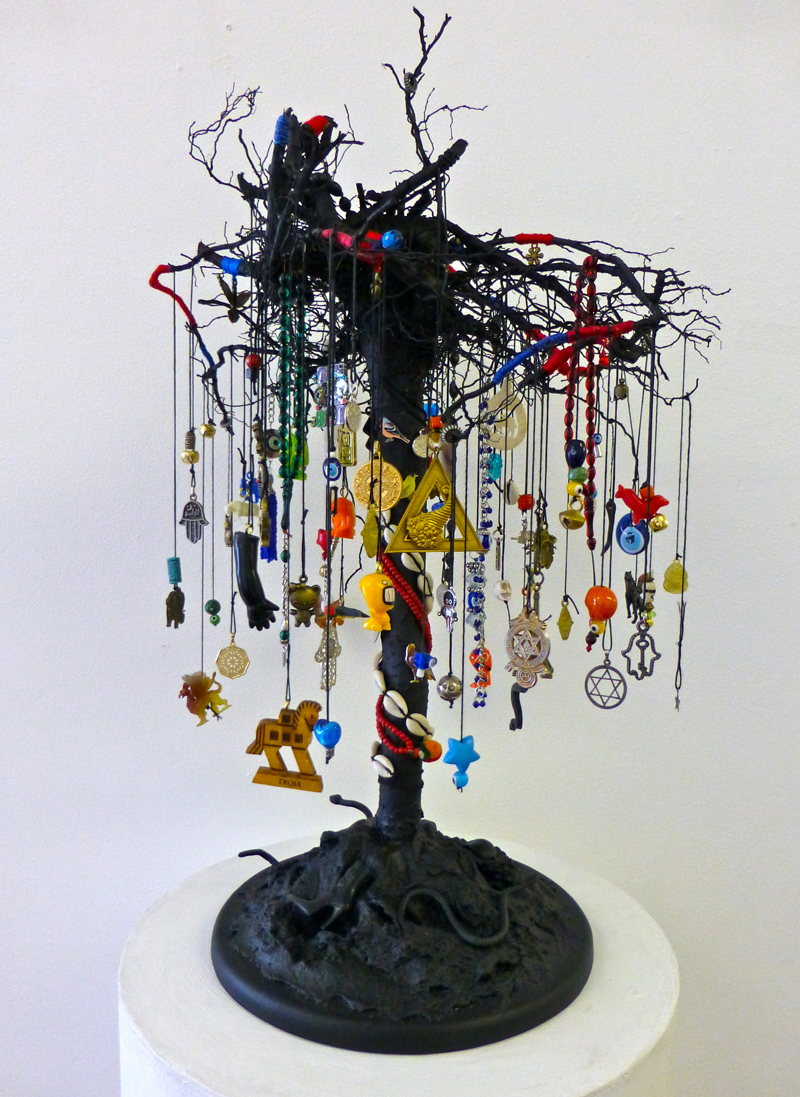
Universal Magic Tree 2013-16
Tree root, disk of MDF, plaster and pva mix around base, blue and red thread, collection of small objects including religious and pagan iconography, amuletic objects, small toys, beads and shells.
This tree root is hung with all manner of objects that have equal importance to all manner of people of any sex, age, race or belief system.
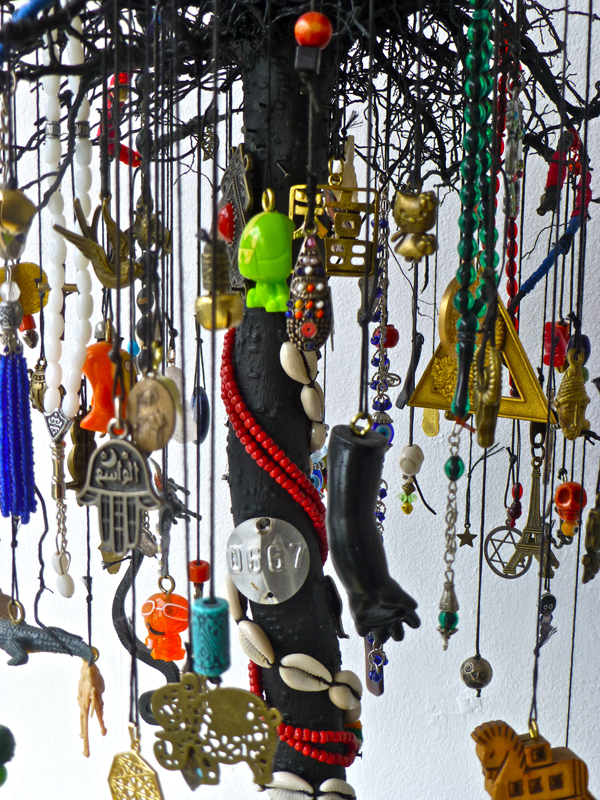
Universal Magic Tree-detail
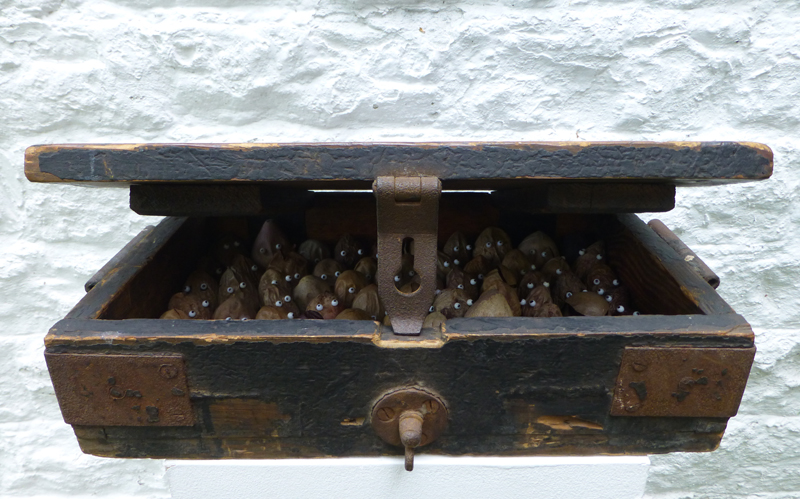
Cache 2013/14 (Cache-a collection of similar items stored in a hidden place)
Ammunition box, avocado stones, mapping pins, marker pen.
I collected the stones from avocados I ate during two years and as they accumulated on my window ledge they began to resemble people of different shapes and sizes. Adding the mapping pin ‘eyes’ I placed them in an old ammunition box that had been in my studio for some years. Listening to the terrible events unfolding in Syria, the civil war and communities bombing one another this work took on the appearance of people sheltering from attack.
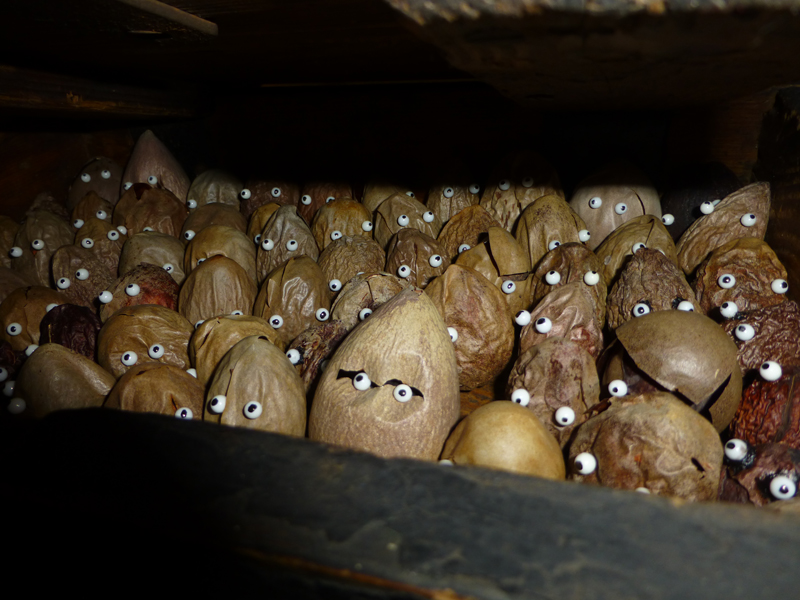
Cache-detail
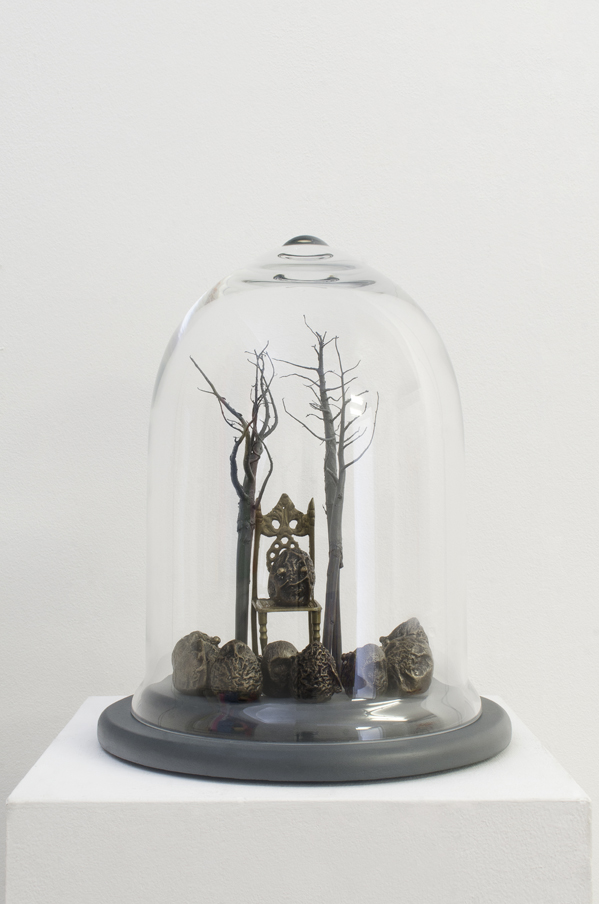
Gathering – 2014
Glass dome containing bronze casts of avocado stones, miniature brass chair, Papaver somniferum (opium poppy) roots.
An artist friend helped me to cast some of the avocado stones in bronze using the ‘lost wax’ method. I liked the idea of taking something that would otherwise be thrown away and transforming it into something precious that would last forever. What will future people think they are, deities? gods? part of a game?
For me, this piece is about the destruction of schools in countries such as Afghanistan, where girl children had to be educated in secret, and classes were held outdoors…but it could be a religious meeting or a meeting of revolutionaries. Like all artworks it is about whatever the viewer sees.
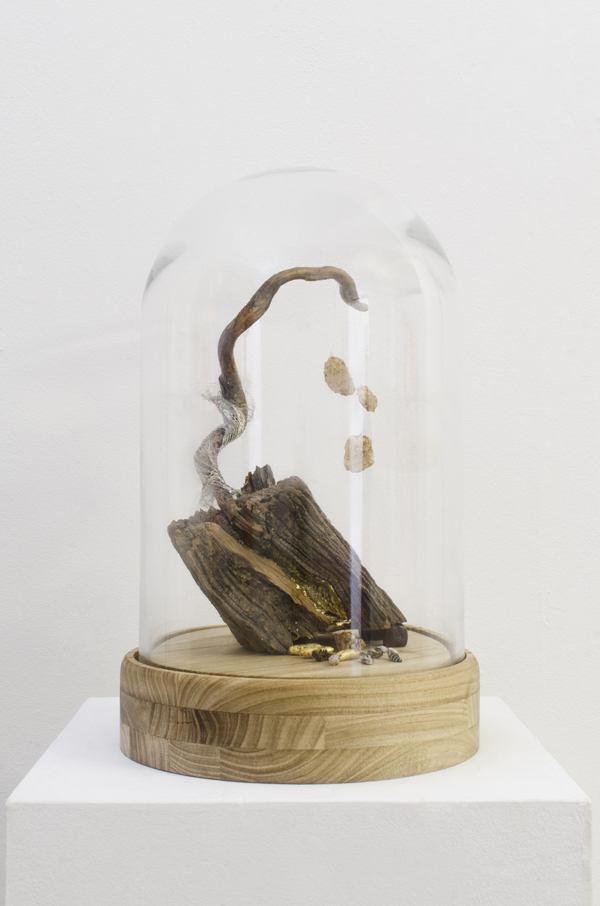
Dystopia – 2016
Glass dome containing heartwood lined with gold leaf, olive branch with silver mesh and silver wire holding wax combs, on the base are three date stones covered in gold leaf and seven virgin queen bees in various phases of metamorphosis.
All the assembled materials in this piece are dead.
According to Charles Darwin, who in 1859 wrote his famous book On the Origin of Species, ‘if all the bees were to die then the human race would not survive since most of our food plants are pollinated by bees’. The precious metals, gold and silver will have no purpose then.
Alarmingly the bee population is declining dramatically due in part to the chemicals used to kill weeds and insects on our food crops.
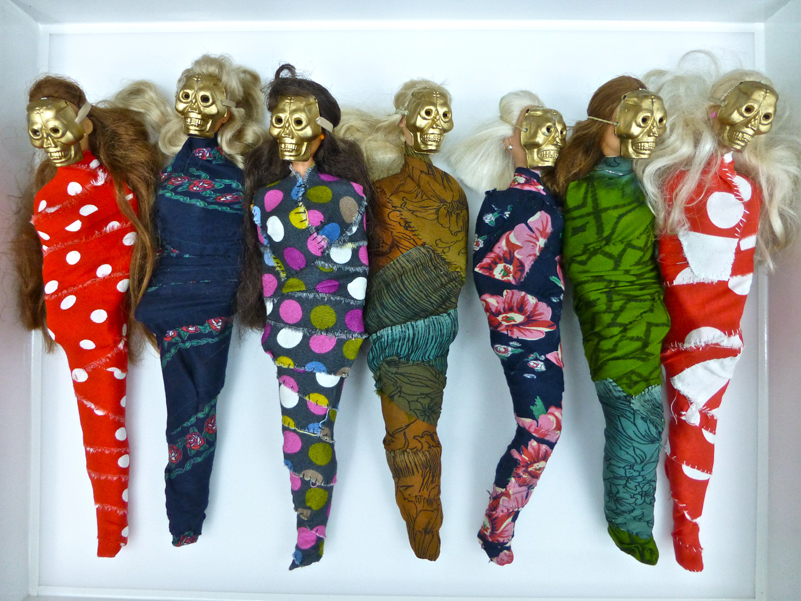
Face Masks and Body Wraps 2015
Butterfly display box containing wrapped Barbie dolls, small Halloween masks, elastic.
This piece addresses the extreme lengths that some women will go to in order to make themselves ‘beautiful’.
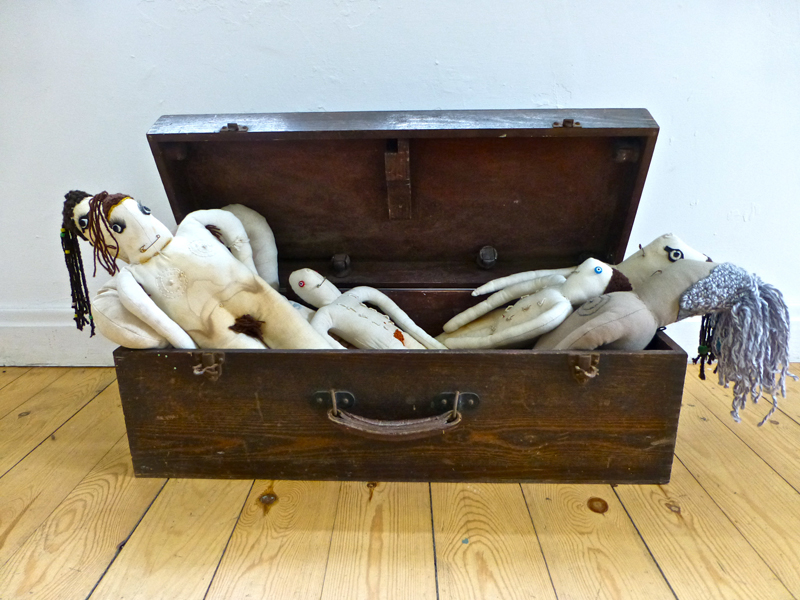
Ladies for the Afterlife (Shabti) -2015
1940’s Electrolux vacuum cleaner box, six embroidered cloth female figures.
Based upon the Ancient Egyptians idea of servants (shabti), who accompanied the dead in order to work for them in the afterlife, I made this ‘tongue in cheek’ assemblage suggesting that we live in a world where women will still be expected to do the cleaning even when we are dead!
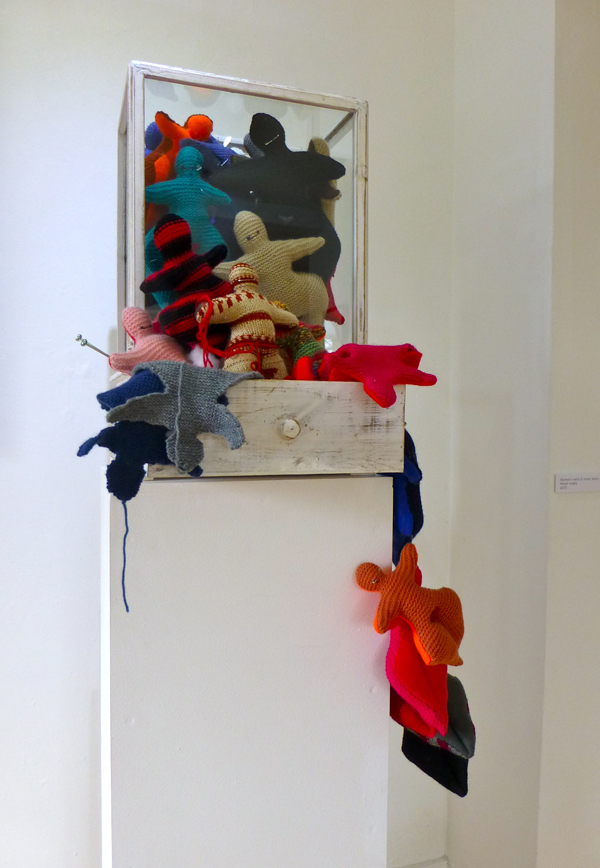
Women’s work is never done…… 2015 to date.
When male archaeologists first came across the many female figures made during the ice age they thought they were dolls or pornography for ice age men! We now understand how fragile those ancient peoples lives were and how important the birth and survival of children was for the tribe. It is now accepted that they were in fact objects made to protect women and their babies during pregnancy and childbirth.
I am continuing to knit the ‘Venus’ figures and add them to this assemblage/installation so it is a work in progress and may ‘never be done’.
